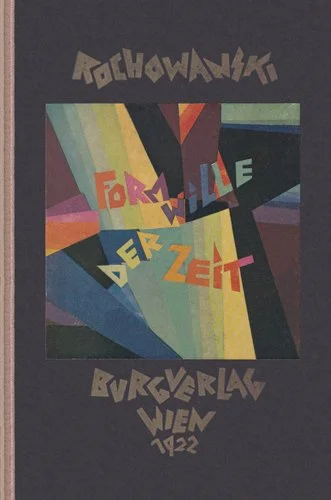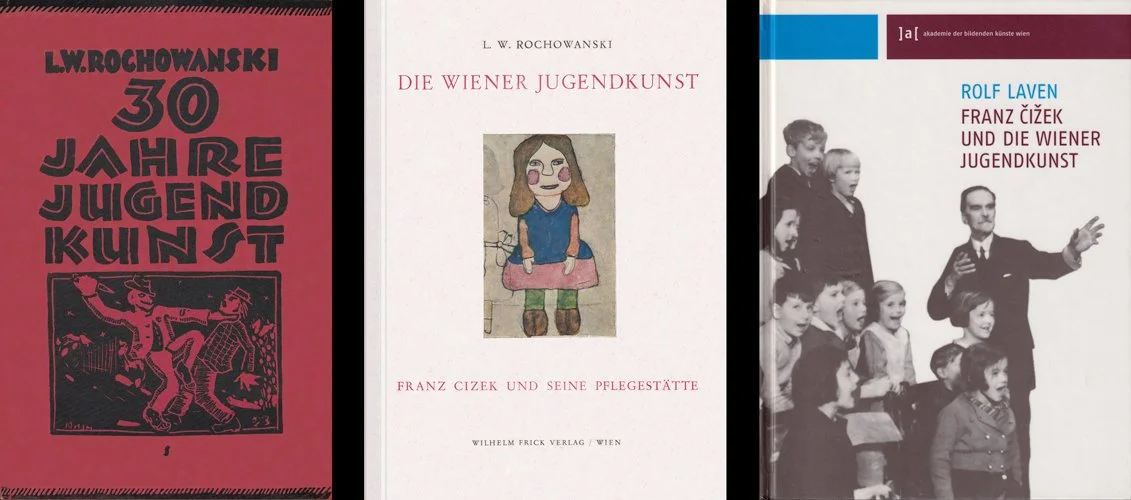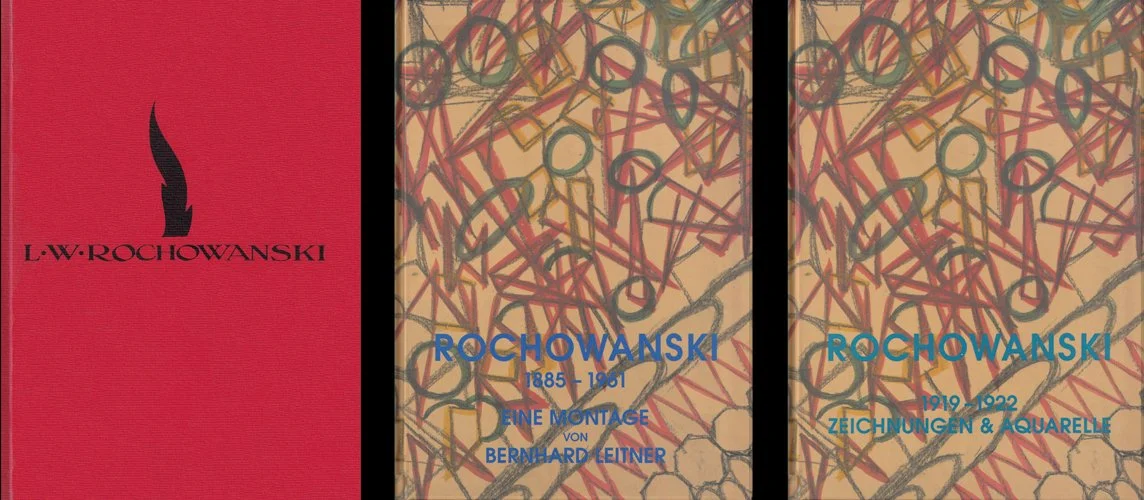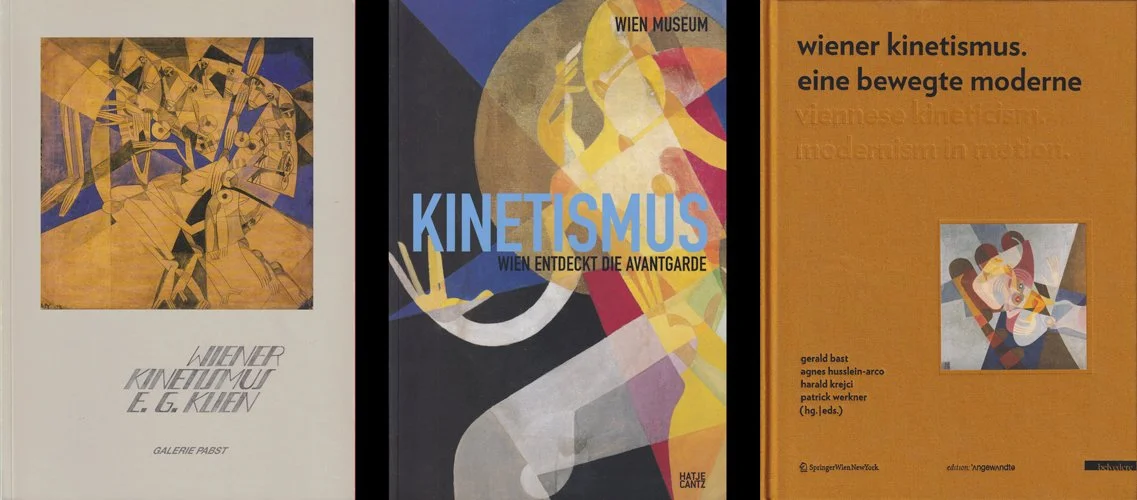Vienna – Art Publications 1922-33
⭆ Collecting | Publications by L. W. Rochowanski in the context of the arts in Vienna between 1922 and 1933Red Vienna represented more than just a synonym for social democratic municipal governance; it signified an era where an entire intellectual framework shifted: from the individual to society, from individual psyche to that of the masses, from the body of the individual to the social body, from desire to need, from a vertical to a horizontal order. Due to its political and humanistic foundations, And yet another aspect of Red Vienna set its works apart from previous eras: Many of the most significant contributions in the fields of art, research, journalism, literature, and politics came from women—both within and outside the social democratic party—ranging from the women's rights activist Therese Schlesinger to the artist and graphic designer Erika Giovanna Klien, and from the reform pedagogue Eugenie Schwarzwald to the psychologist Charlotte Bühler.
Formwille der Zeit. L.W. Rochowanski. Vienna: Burgverlag, 1922
The writer, publisher, exhibition organizer, librettist, and dancer Leopold W. Rochowanski (1885–1961) served as the mouthpiece and chronicler of the "Vienna Youth Art Class" led by Franz Čižek (1865–1946). This class was established as a separate department at the Vienna School of Arts and Crafts and aimed to organize art education according to modern principles. Following Čižek's conviction, supported by the school reformer Otto Glöckel (1874–1935) and in contact with Maria Montessori (1870–1952) as well as the German reform architect Heinrich Tessenow (1875–1950), the promotion of free, innate creative talent in every individual was to replace the traditional practice of copying models. This art educational approach, which correlated with the socio-political ideas of Red Vienna, attracted international attention. Čižek's classes, attended by many girls and young women and considered a nucleus of Kineticism (an Austrian variant of Futurism), exhibited in the 1920s and 1930s in England, the USA, and Canada, among other places. Rochowanski's published reflections, taken from the richly illustrated and graphically designed publication "Formwille der Zeit," authored by Rochowanski himself, introduce the pedagogical principles of the youth art class and link them with central art theoretical concepts of the time
Der tanzende Schwerpunkt. L.W. Rochowanski. Vienna: Amalthea, 1923
Der brennende Mensch. L.W. Rochowanski. Vienna: Literaria, 1923
Psychopathische Künstler. L.W. Rochowanski. Vienna: Otto Claus, 1923
Wiener Keramik. L.W. Rochowanski. Vienna: Thyros, 1923
Streiflichter auf die österreichischen Eisenbahnen. Otto Günther. Cover design by Erika Giovanna Klien. Vienna: Hölder-Pichler-Tempsky, 1924
Two Groschen coin and One Schilling postage stamp both from 1925. The stamp set included 27 stamps with different values in Austrian Groschen and Schilling.
Children's coloured paper work. Franz Cizek. Vienna: Anton Schroll, 1925
Considered the "founder of youth art education" Franz Čižek’s work influenced the way art schools were organized in Austria, but also particularly in Great Britain and the USA. This prompted him to publish his portfolio "Papier-Schneide und Klebearbeiten" in English in 1925. It was published with a text booklet and 24 panels showing the results of his teaching at his school in Vienna.
Das Buch der Gesamtverbandes schaffender Künstler Österreichs. Vienna: Ebenmühl, 1929
Contemporary Art Applied to the Store and its Display. Friedrich Kiesler. New York, 1930
Emerging from a Constructivist context, Austrian-born émigré Frederick Kiesler explicitly embraced the shared ground between aesthetics, fine art, and commodity display. Kiesler’s window designs for Saks Fifth Avenue in New York (1928) were his financial salvation and revolutionized commercial window display in the process. Gone were the typological cavalcades of the kind documented by Eugène Atget in Paris, and in their place was an all-encompassing visual system running the length of the building’s façade, 14 interconnected window spaces built into an abstracted theatrical set, staging select items – say a single jacket draped over a chair – as fetishized elements within a singular idealized context. The uncluttered and unashamedly aestheticized modernity of the presentation was a sensation, the three-week commission remaining installed for the next nine years, and so successful that in 1930 Kiesler was able to publish an intelligent guidebook, succinctly titled Contemporary Art Applied to the Store and its Display. I was happy to find an almost mint copy of this sought after book in Japan. [PDF]
Österreichisches Kunstgewerbe – A Guide to Austrian Arts and Crafts. L.W. Rochowanski. Vienna: Heinz & Comp, 1930
The extremely rare dustcover was designed by Josef Hoffmann.
18 wachsende Häuser. L.W. Rochowanski. Vienna, 1932
An yet another wonderful cover design by Elsa Engel-Meinfelden for this hard to find publication by L.W. Rochowanski. The booklet is the catalogue for the special exhibition of the same name at the 1932 Vienna Spring Fair. The exhibition presented the results of an architectural competition to develop low-cost housing estates. A total of 18 projects were awarded prizes and erected in the Prater. The idea behind the projects was that there was a "core house" of about 30 square metres that could be extended to in further construction phases – this also explains the title "growing houses". Similar to the Werkbund exhibition, the houses were fully furnished and could be visited during opening hours. Das österreichische Lichtbild. L. W. Rochowanski. Vienna: Heinz & Comp, 1933
⭆ Further readings and secondary literature
30 Jahre Jugendkunst. L.W. Rochowanski. Troppau: Heinz & Co, 1928
Die Wiener Jugendkunst. Franz Čižek und seine Pflegestätte. L.W. Rochowanski. Vienna: Frick, 1946
2nd, expanded post-war edition of "30 Years of Youth Art." What Cizek achieved with the discovery of the children's soul and their creativity is renowned throughout the world. (back cover text)
Franz Čižek und die Wiener Jugendkunst. Rolf Laven. Vienna: Akademie der bildenden Künste, 2006
L.W. Rochowanski. Aquarelle – Zeichnungen 1919-1921. Vienna: Hochschule für angewandte Kunst, 1987
Catalogue for an exhibition by the University of applied arts in cooperation with Julius Hummel Gallery that took place in Vienna between March and April 1987. The foreword is by the then director of the university, Oswald Oberhuber, with a short biographical sketch by my friend Vera Vogelsberger, a dear friend who sadly died far too early. Oswald Oberhuber made great contributions to the reappraisal of the Austrian avant-garde of the interwar period and laid the foundation for the university's outstanding collection in this field. Two years prior to this relatively small exhibition, there was a much more comprehensive survey under his direction entitled The Expulsion of the Intellectual from Austria (Die Vertreibung des Geistigen aus Österreich).
Rochowanski I. 1885-1951 – Eine Montage. Bernhard Leitner. Ostfildern-Ruit: Cantz, 1995
Rochowanski II. 1919-1922 – Zeichnungen & Aquarelle. Bernhard Leitner. Ostfildern-Ruit: Cantz, 1995
Erika Giovanna Klien. 1900-1957. Exhibition catalogue. Vienna: Museum moderner Kunst, 1987
Erika Giovanna Klien. Wien New York 1900-1957. Bernhard Leitner (Ed). Ostfildern-Ruit: Cantz, 2001
Wiener Kinetismus. E. G. Klien. Sales catalogue. Munich: Galerie Michael Pabst, 1986
Kinetismus. Wien entdeckt die Avantgarde. Exhibition catalogue. Vienna: Wine Museum, 2006
Wiener Kinetismus. Eine bewegte Moderne. Gerald Bast (Ed). Vienna: Springer, 2011
Bauhaus in Wien? Katharina Hövelmann. Vienna: Böhlau, 2021
Friedl Dicker-Brandeis. Reutner-Doneus, Schmutz (Eds). Munich: Hirmer, 2022
Atelier Bauhaus, Wien. Friedl Dicker und Franz Singer. Hövelmann, Nierhaus, Schrom (Eds). Salzburg: Müry Salzmann, 2022
Friedl Dicker-Brandeis. Kitzberger, Rainer, Schädler (Eds). Vienna: Edition Angewandte, De Gruyter, 2022
















